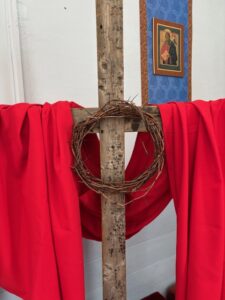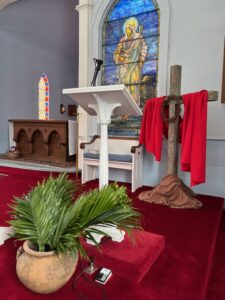April 13, 2025
Delivered by the Rev. Dr. Margaret Bullitt-Jonas at St. John’s Episcopal Church, Ashfield, MA
Luke 19:28-40 (Liturgy of the Palms)
Luke 22:14-23:56
Resistance rooted in love
I’d like to begin where today’s service began – with Jesus’ triumphal procession into Jerusalem, riding on a donkey. As you may know, theologians Marcus Borg and John Dominic Crossan pointed out with great insight some twenty years ago that this procession is charged not only with spiritual meaning, but also with political meaning. Jesus is heading “to the capital city of his people to confront Roman imperial power and religious collaboration with it.”1 He is heading to Jerusalem to proclaim the power of God’s love over the powers of this world that rule by force and domination.
That’s the procession that we remember every year on Palm Sunday and that we re-enact as we walk into church, palm branches held high. But, as Borg and Crossan point out, today we also remember a second procession that was entering Jerusalem at the same time, at the beginning of the week of Passover. Passover was what they call a “tinderbox time” in Jerusalem,2 when the Jewish people, oppressed and crushed by Roman rule, celebrated their divine liberation from the Egyptian Empire. Riots against the Roman Empire would sometimes break out at Passover, so every year the Roman governor – which, in the time of Jesus, was Pilate – would ride up to Jerusalem from the west, from the imperial capital of Caesarea, in a mighty show of force.

Our theologians invite us to imagine that imperial procession – cavalry on horseback, foot soldiers, banners, weapons gleaming in the sun, the sound of beating drums and marching feet, the smell of dust. Pilate’s procession from the west symbolized Roman imperial power.
By contrast, Jesus entered the city from the east, in what these theologians call a “counterprocession.” Whereas Pilate rode into the city on a war-horse, Jesus entered on a donkey. He chose to ride this humble animal because it recalls the prophet Zechariah, who predicted that the king of peace would come on a donkey (Zechariah 9:9-10). The king of peace would bring an end to war – no more chariots. No more war-horses. No more bowing and scraping. No more empire.
The procession that we re-enact on Palm Sunday is an act of resistance. The scene recorded in Luke’s Gospel in the Liturgy of the Palms sounds a lot like a conversation among people in the underground who plan in advance and speak in passwords to keep their arrangements secret. Jesus tells two of the disciples to go into the village ahead and to find a certain colt (that is, a young donkey), and he says, “If anyone asks you, “‘Why are you untying it?’ just say this, ‘The Lord needs it’” (Luke 19:30). If you’ve ever been part of a secret plan for non-violent civil disobedience, this is what it sounds like.
So, Palm Sunday presents us with two processions on a collision course: Jesus and Pilate, the Kingdom of God and the kingdom of Caesar.
I thought about this last week when I marched with tens of thousands of people through the streets of Boston. I know that several of you were also in Boston, and that others took part in local protests. Indeed, last Saturday over 1,200 “Hands Off” mass action protests were held across the country. Millions of Americans expressed their protest of what looks to many of us like the beginning of a police state in which opposition is silenced, dissidents are punished, the rule of law is overturned, and power is concentrated in the hands of a few wealthy men.
As I wrote in a blog post about the Boston rally, I rode the bus to Boston and shared the march and rally with Bishop Doug Fisher. I found it particularly moving to walk with him past the Episcopal cathedral in downtown Boston as the crowd slowly made its way up Tremont Street to Boston City Plaza. A big sign outside the cathedral listed the upcoming worship services for Holy Week, starting with Palm Sunday. And here we were, two thousand years later, in our own resolute and peaceful procession to protest Empire. The cathedral’s steps were filled with demonstrators and its doors were open to welcome anyone who wanted a quiet space, a drink of water, a bathroom break, or some words of support or prayer. I was grateful once again for Episcopalians and for all people of faith and goodwill who stand up against tyranny.
We are now entering the holiest days of the Christian calendar and marking the final week of Jesus’ life. Most of us have experienced these services many times and have contemplated many times the story of Jesus’ last days. Every year, through acts of prayerful imagination, we listen to these stories, and we try to visualize what Jesus was enduring and find our own place in the narrative. But this year feels different. This year, the reality of Empire, the reality of the machinery of cruelty and greed, has suddenly become vivid to us, suddenly become real.
I am filled with questions. How did Jesus find the strength – how do we find the strength – to proclaim the sovereignty of God in a society so corrupt and unjust that dissidents can be picked off the streets, detained on bogus charges, subjected to torture and humiliation, and, in Jesus’ case, almost casually executed? How did he – how do we – come to love God and neighbor so passionately that we are willing to give our lives to express that love? How did he – how do we – find the physical and moral courage to keep standing with the outcast and the condemned, to endure great suffering, and yet to maintain a merciful and forgiving heart? These are some of the questions I hold as we enter Holy Week.
I know that Jesus will help us find our way and give us the strength to follow him through this dark time with courage and faithfulness. I invite you to come to all the services and to give yourself the gift of being close to Jesus as we walk with him, and he walks with us.

I’d like to end by sharing a very simple way of praying that has meant a lot to me over the years and that you might find helpful as we walk the way of the love with Jesus. As I imagine it, the cross is not far away in Golgotha or limited to any single place and time. The cross of Christ is planted deep within me, deep within you, and at the cross I can pour out my anger, my fear, my grief, for I trust that at the cross of Christ, everything is perpetually being met by the forgiving love of God. Whatever I need to feel and to express – rage, sorrow, fear, guilt, whatever – all of it is being met by the never-failing, boundless love of God. Everything that we bring to God is transformed at the cross. It’s like alchemy, like piling up food scraps and turning it into good compost. As I see it, crucifixion is the place where God breaks through our numbness and denial and our hearts open wide to love the world in all its suffering and pain, in all its beauty and fragility.
At the cross, we allow ourselves to feel anger – because anger is an expression of love. We allow ourselves to feel emptiness – because emptiness creates a space for something new to arise. We allow ourselves to feel sorrow – because shedding tears can water the soul and bring new life. We allow ourselves to feel fear – for that in itself is an act of courage.3 Praying at the cross is where we can finally face and bear what we find so challenging, and where God in Christ can hold and bear for us what we cannot bear ourselves. Learning to breathe into the cross, allowing the power and love of God to make contact with everything that’s in us, sets us free from being reactive and helps us weave God’s love and strength into our very being.
We are not alone. Jesus is living these days with us and through us. From within your own life, with all its responsibilities, what is yours to do in this precarious time? How is Jesus inviting you to walk the path of love?
_________________________________________________________________________________________________________
1. Marcus J. Borg and John Dominic Crossan, “Collision Course: Jesus’ Final Week,” Christian Century, March 20, 2007, p. 29. This homily is indebted to these scholars’ work. For a longer treatment, see Marcus J. Borg and John Dominic Crossan, The Last Week: What the Gospels Really Teach about Jesus’ Final Days
2. Ibid.
3. I’m indebted to Joanna Macy and Chris Johnstone, Active Hope: How to Face the Mess We’re in without Going Crazy (Novato, California: New World Library, 2012), especially the exercise “Breathing Through,” 73-75. For a more detailed presentation of the prayer that I call “Grounding in the Cross,” see Margaret Bullitt-Jonas, Christ’s Passion, Our Passions: Reflections on the Seven Last Words from the Cross (Cambridge, MA: Cowley Publications, 2002), 9-12.
